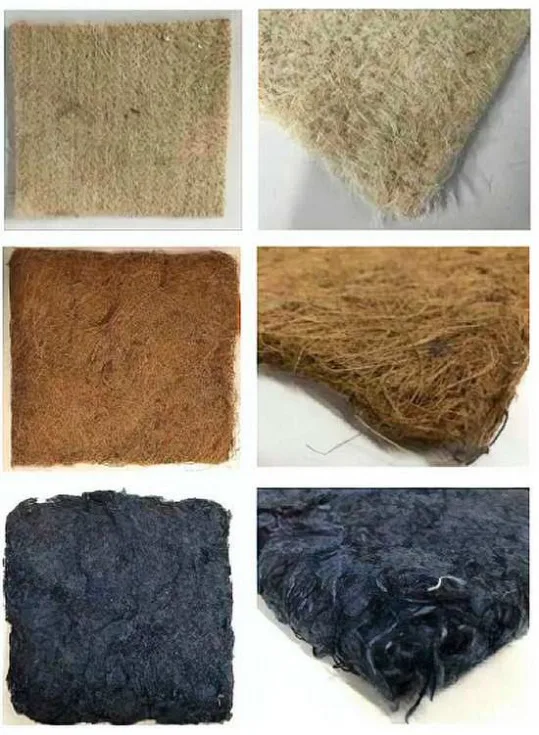Changing current patterns of building design and operation to make buildings more energy efficient and sustainable is one of the major challenges facing the building sector today. If buildings are designed and used properly, significant energy savings can be achieved. In this respect, thermal and acoustic insulation materials (especially the former) play an important role and can be a first step in achieving better energy efficiency.
In this context, researchers from the Architectural Acoustics Research Group at the School of Architecture of the Polytechnic University of Madrid (UPM) in Spain have evaluated the potential of plant fibres as an alternative for thermal and acoustic insulation of buildings and their results have been promising.
Fique, coconut and cotton fibres recycled from denim were the materials used by the ETSAM researchers for this work, in which the Pontifical Bolivarian University of Medellín (Colombia) also participated.
"The aim is to design materials with high acoustic and thermal performance that are cheap, biodegradable and recyclable," explains María Ángeles Navacerrada, a researcher at ETSAM and one of the authors of this study. "We produce non-woven samples, i.e. without having to convert the fibres into yarn. The result is flexible and porous fibre sheets without weft," she adds.
Once obtained, the new fibres were subjected to several tests to assess their thermal and acoustic properties in order to evaluate their potential for use in construction, taking into account the requirement parameters of the Spanish Technical Building Code (CTE) in its Basic Documents on Energy Saving (DB-HE) and Noise Protection (DB-HR).
In all three cases, the fibres gave results comparable to those of materials currently used in construction.
With fique, samples were made from the waste resulting from its applications in twine and packaging. The fibre obtained can withstand temperatures of 220 degrees Celsius without degrading and was shown not to absorb moisture easily. Coconut fibre is obtained as a residue from fruit fibres and has been widely used as a reinforcement material for cements. It has the advantage that after use it can be incorporated into the soil as compost.
In the case of cotton, the researchers used denim remnants. "In the European Union, more than 6 million tonnes of textile garments are discarded by consumers, of which only 25 per cent are recycled; the rest go to landfill or are incinerated. Using them in the manufacture of this type of fibre gives them a new life and contributes to eliminating this waste," says Navacerrada.
The manufactured samples have a density of approximately 80 kg/m3. The researchers measured their thermal conductivity, and acoustic parameters such as dynamic stiffness and sound absorption coefficient.

"The thermal conductivity of the manufactured samples is comparable to that of conventional thermal insulators, reaching a value of 0.038 W/mK in the case of the sample made of cotton. Judging from these results, the manufactured materials could be used as thermal insulators in external enclosures, internal partitions and roofs. A thickness of 10 cm would be adequate for the thermal envelope of the building and for interior partitions of the same and different uses a thickness of 5 cm would be sufficient," explains Navacerrada.
The results do not disappoint in the case of sound insulation either. "We analysed the possibilities of the manufactured materials for sound insulation and acoustic conditioning. The improvement of the global index of acoustic reduction to airborne noise in a wall cladding in which the chamber is filled with these materials and the one obtained with denim and coconut is comparable to the one obtained with mineral wool," explains the UPM researcher.
The data also supports their use in horizontal separation elements. "In order to prevent the transmission of impact noise, horizontal separation elements often have a floating floor for which insulating materials made of elastic and flexible materials, usually polyurethane, are used. These characteristics are also present in materials made from fique, coconut and denim. In a horizontal separator element that is a homogeneous slab of 175-180 kg/m2, the reduction in the overall level of impact noise insulation due to a floating floor in which the elastic layer is made of these materials would meet the requirements of the Basic Document on Noise Protection", says Navacerrada. "In addition, due to their porous structure, the manufactured materials show a good acoustic absorption behaviour at intermediate and high frequencies, comparable to that of the materials currently used", explains Navacerrada.
For the researchers, the results offer an open door to the use of this type of fibres to improve the sustainability of buildings, although they warn that more tests and trials are needed before a clear commitment can be made.
"During the selection of a material, in addition to its acoustic and thermal properties, other factors such as availability, energy impact or cost must be taken into account. Also economic and commercial aspects or issues and some physical properties, such as water vapour resistance and fire performance," concludes Navacerrada (Source: UPM). (Source: UPM).